 |
 |
 |
| |
Half of 50-Plus HIV Group Lonely, But Loneliness Declines in the 60s
|
| |
| |
IDWeek 2018, October 3-7, 2018, San Francisco
Loneliness in >50 Year Olds: 48% in HIV+ vs 18% in HIV-neg
from Jules: 2-3 Times Higher Loneliness in HIV+ (74% had 5 or more comorbidities; 80% were white; 40% income >40k; 55% at least a college education; 86% MSM; 93% undetectable viral load; 84% adherent: pretty privileged group) - 48.3% of subjects (> 50 years old)were classified as lonely according to the UCLA Loneliness Scale-3, with scores ranging from 3-9,,,,,In HIV+ >65 36% were lonely.......A previous study, also using the short form of the UCLA Loneliness Scale, reported an 18.1% prevalence of loneliness in an older (ages 52 and above) non-diseased population....A cross-sectional analysis of the impact of aging on loneliness was performed using data on 693 ADHOC participants with HIV who were at least fifty years of age......mean age of participants was 58.9 ± 6.1 years. The age distribution of ADHOC participants was as follows: 64.2% were 50-59, 18.3% were 60-64, 17.5% were 65+ (Figure 1)......older age associated with decreased loneliness (p=0.005) (Figure 2)..... in looking at Table 2 (and Table 1) below associated with being lonely appeared to be: being straight, heterosexual; being single; income <50k; having more education; working; depression; recreational drug use; worse self reported quality of life and worse social well-being & social quality of life; "hazardous" alcohol use; smoking cigarettes; good adherence.
Mark Mascolini
Almost half of 693 HIV-positive people 50 or older felt lonely, according to results of a standard test [1]. But as people aged into their 60s, loneliness became less frequent.
Frailty, cognitive problems, and multimorbidity affect growing proportions of people as they age, and these problems are often more common in aging people with HIV. Loneliness is a frequent but little-studied challenge of aging. It may be particularly severe in older people with HIV, whose spouses and friends may have died and whose families may be geographically or emotionally distant.
Investigators working with Mazonson & Santas, a health services consulting firm, and the pharmaceutical company ViiV Healthcare conducted a new study to learn more about the prevalence and correlates of loneliness in people with HIV. To inform this work, in 2017 they created an online HIV community called Aging With Dignity, Health, Optimism, and Community (ADHOC). Participants self-report sociodemographics, health care use and satisfaction, HIV-related factors including antiretroviral therapy, and behavioral variables like sexual practices and substance use. So far HIV care providers have identified and recruited ADHOC participants in 6 states and Washington, DC.
This analysis focused on 693 people enrolled in ADHOC through July 18, 2018. They completed the 3-question short form of the UCLA Loneliness Scale, with a score of 6 or higher indicating loneliness. The researchers used multivariable logistic regression to identify loneliness predictors. The group averaged 58.9 years in age: 64.2% were 50-59, 18.3% were 60-64, and 17.5% were 65 or older. Over 90% of participants were men and about three quarters white.
Of the 693 participants, 335 (48.3%) were lonely according to the UCLA Loneliness Scale. Loneliness prevalence dropped with age, affecting 52.6% of the 50-59 group, 44.9% of the 60-64 group, and 36.4% of the 65+ group (P = 0.005). This inverse correlation with age held true whether the researchers considered loneliness a categorical variable or a continuous variable.
The loneliness rate did not differ by gender or race, but several demographic and clinical factors varied significantly by loneliness status. Loneliness was more frequent in single people than in those in a relationship (P < 0.001), in people living alone (P < 0.001), in those with an income below versus above $50,000 (P < 0.001), in people with poor versus good antiretroviral adherence (P = 0.035), in people with anxiety or depression (P < 0.001 for both), in people with more than 5 comorbidities (P < 0.001), and in current smokers (P = 0.004). Three quality-of-life measures (PozQoL overall scores, PozQoL social score, and FAHI-determined social well-being) were higher in older people and lower in lonely people.
In the full multivariate model, odds of loneliness were 45% lower in people 60 to 64 versus 50 to 59 (P = 0.015) and 66% lower in people 65 or older versus 50 to 59 (P < 0.001). Multivariate analysis identified 6 other independent predictors of loneliness: being single (adjusted odds ratio [aOR] 2.34, P = 0.001), living alone (aOR 2.12, P = 0.008), college education versus less (aOR 2.43, P < 0.001), depression (aOR 2.30, P = 0.019), recreational drug use (aOR 1.59, P = 0.045), and current smoking (aOR 1.85, P = 0.046).
The researchers noted that a previous study using the same loneliness scale found an 18.1% loneliness prevalence in a non-HIV group 52 years old or older [2], compared with the 48.3% prevalence in the ADHOC HIV group. In 836 HIV-positive Canadians 35 or older, a single-question test determined that 18% felt lonely "quite often" and 46% "sometimes" felt lonely [3]. As in the new US study, older Canadian study participants felt lonely less often than younger (35-to-45) participants.
The US investigators concluded that loneliness is highly prevalent in this HIV population. They noted that the inverse relationship between aging and loneliness "was mirrored by the observation that quality of life improved as age increased." One might also surmise that, as people age, those more active and socially engaged may be more likely to join an online community like ADHOC.
References
1. Kane M, Mazonson P, Zolopa A, Spinelli F, Ferrer PE, Shalit P. Loneliness among older adults living with HIV: a study and online community. IDWeek 2018, October 3-7, 2018, San Francisco. Abstract 605. Poster at https://idsa.confex.com/idsa/2018/webprogram/Paper69947.html
2. Steptoe A, Shankar A, Demakakos P, Wardle J. Social isolation, loneliness, and all-cause mortality in older men and women. Proc Natl Acad Sci USA. 2013;110:5797-5801.
3. Harris M, Brouillette M, Mayo N, Smaill F, Smith G, Thomas R, Fellows L. Associations of loneliness with cognitive function and quality of life (QoL) among older adults living with HIV. 9th International Workshop on HIV and Aging, September 13-14, 2018, New York. Abstract 12. http://www.natap.org/2018/AGE/AGE_23.htm

Mark Kane, MPH1, Peter Mazonson, MD, MBA1, Andrew Zolopa, MD2, Frank Spinelli, MD, FACP2, Pedro Eitz Ferrer, BSc MPH PHD2 and Peter Shalit, MD, PhD3
(1) Mazonson & Santas, Inc., Larkspur, CA. (2) ViiV Healthcare, Raleigh, NC. (3) Peter Shalit, MD and Associates, Seattle, WA.

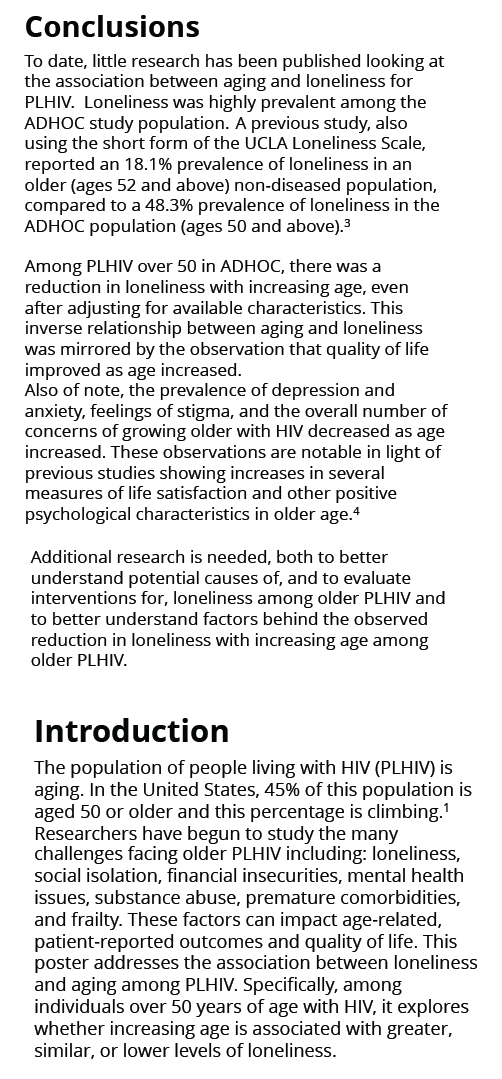
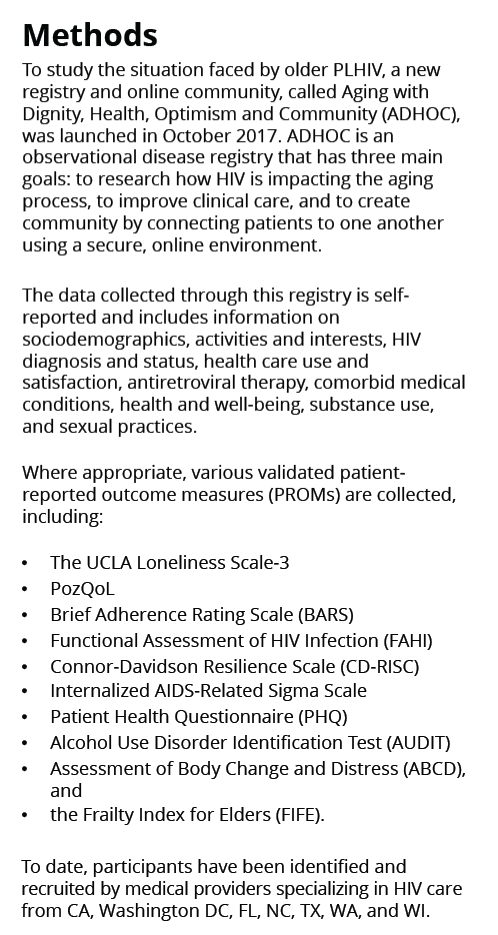


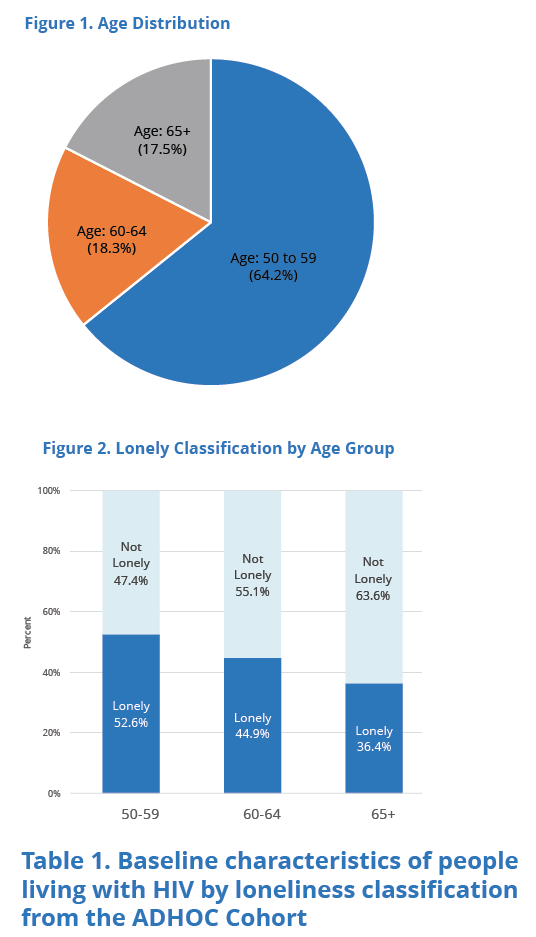
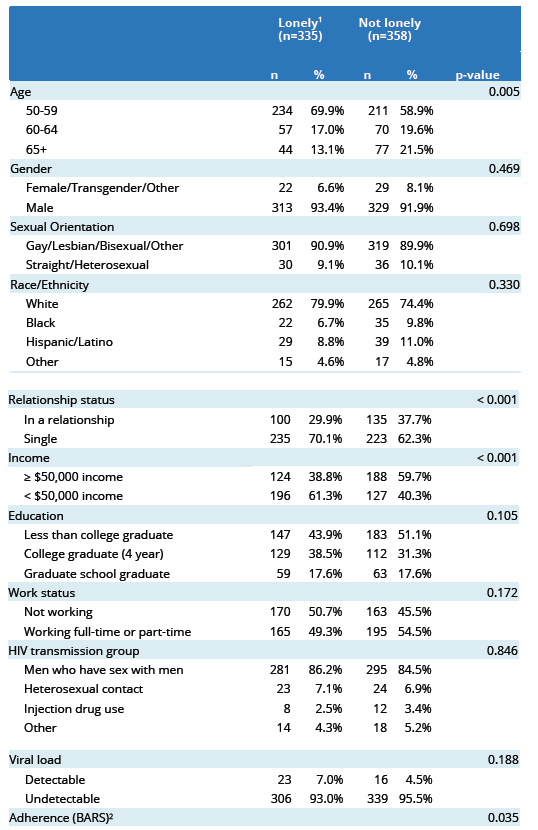
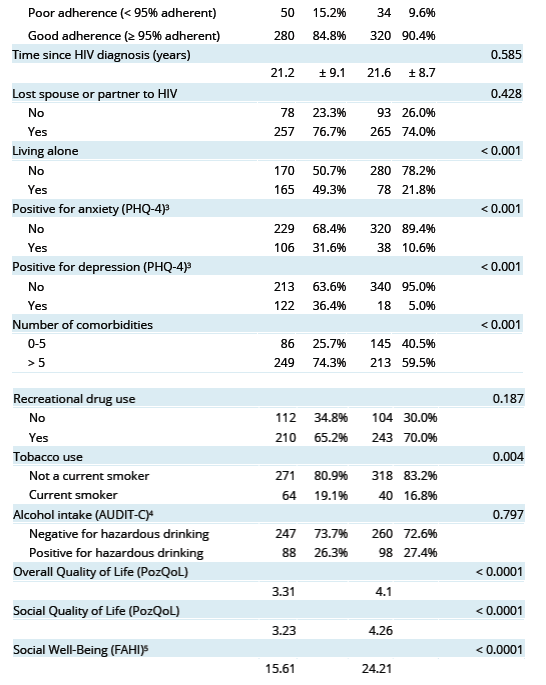

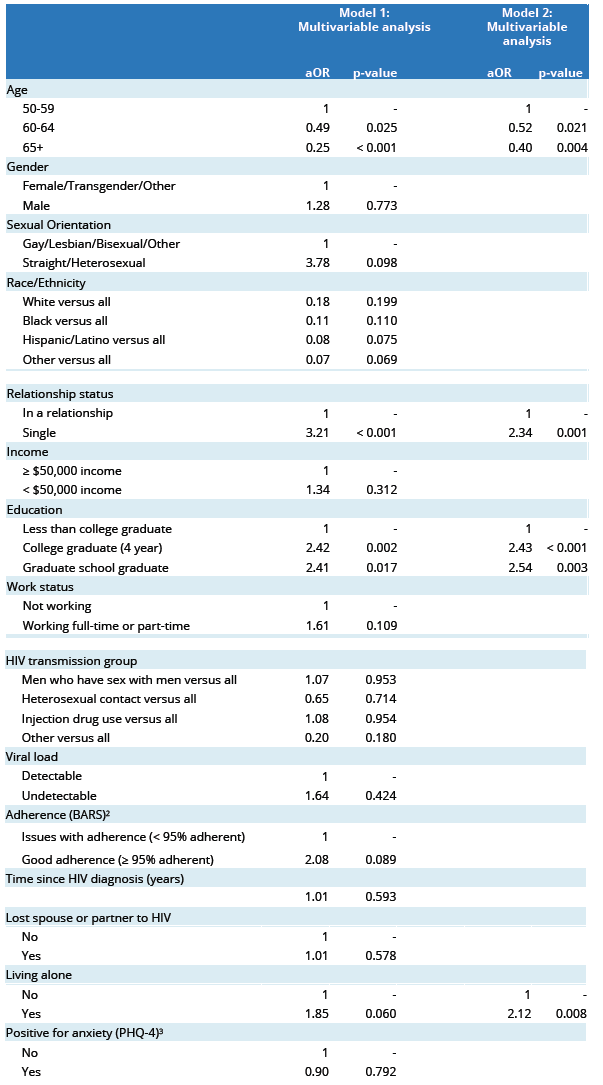
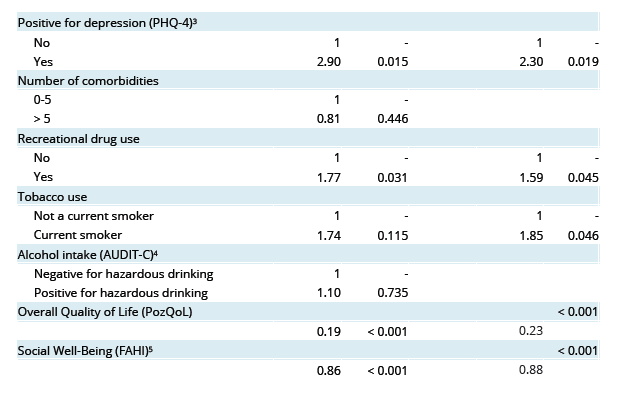
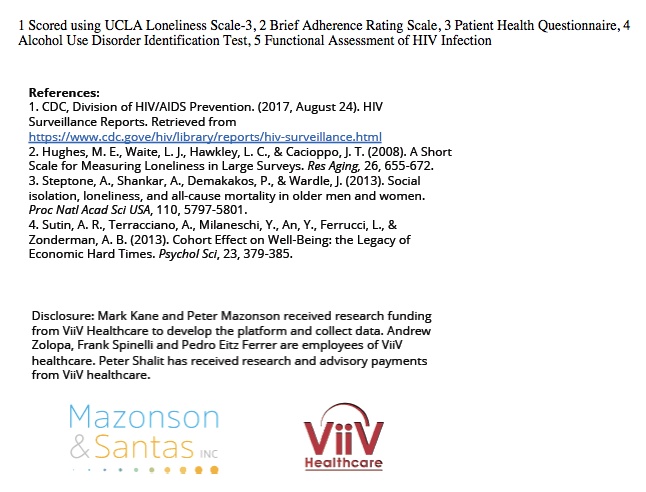
|
| |
|
 |
 |
|
|